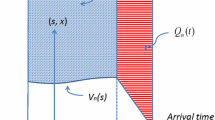Abstract
In this paper a fluid approximation, also known as a functional strong law of large numbers (FSLLN) for a GI/G/1 queue under a processor-sharing service discipline is established and its properties are analysed. The fluid limit depends on the arrival rate, the service time distribution of the initial customers, and the service time distribution of the arriving customers. This is in contrast to the known result for the GI/G/1 queue under a FIFO service discipline, where the fluid limit is piecewise linear and depends on the service time distribution only through its mean. The piecewise linear form of the limit can be recovered by an equilibrium type choice of the initial service distribution.
Similar content being viewed by others
References
S. Asmussen, Applied Probability and Queues (Wiley, New York, 1987).
D. Atkins and H. Chen, Performance evaluation of scheduling control of queueing networks: Fluid model heuristics, Queueing Systems 21 (1994) 391–413.
F. Avram, D. Bertsimas and M. Ricard, Fluid models of sequencing problems in open queueing networks: An optimal control approach, in: Stochastic Networks - IMA Volumes in Mathematics and its Applications, eds. F.P. Kelly and R. Williams (Springer, New York, 1995) pp. 199–234.
P. Billingsley, Convergence of Probability Measures (Wiley, New York, 1968).
D.D. Botvich and A.A. Zamyatin, Ergodicity of conservative communication networks, Rapport de recherche, 1772, INTRA (October 1992).
M. Bramson, Instability of FIFO queueing networks, Ann. Appl. Probab. 4 (1994) 414–431.
M. Bramson, Instability of FIFO queueing networks with quick service times, Ann. Appl. Probab. 4 (1994) 693–718.
M. Bramson, Convergence to equilibria for fluid models of FIFO queueing networks, Queueing Systems 22 (1996) 5–45.
M. Bramson, Convergence to equilibria for fluid models of head of the line proportional processor sharing queueing networks, Queueing Systems (1996, to appear).
H. Chen, Fluid approximations and stability of multiclass queueing networks: Work-conserving discipline, Ann. Appl. Probab. 5 (1995) 637–655.
H. Chen and A. Mandelbaum, Discrete flow networks: Bottleneck analysis and fluid approximations, Math. Oper. Res. 16 (1991) 408–446.
H. Chen and A. Mandelbaum, Hierarchical modeling of stochastic networks, Part I: Fluid models, in: Stochastic Modeling and Analysis of Manufacturing Systems, ed. D.D. Yao (Springer, 1994) pp. 47–105.
H. Chen and D.D. Yao, Dynamic scheduling of a multiclass fluid network, Oper. Res. 41 (1993) 1104–1115.
H. Chen and H. Zhang, Stability of multiclass queueing networks under FIFO service discipline, Math. Oper. Res. (1996, to appear).
H. Chen and H. Zhang, Stability of multiclass queueing networks under priority service disciplines (submitted).
J.G. Dai, On positive Harris recurrence of multiclass queueing networks: A unified approach via fluid limit models, Ann. Appl. Probab. 5 (1995) 49–77.
J.G. Dai, A fluid-limit model criterion for instability of multiclass queueing networks, Ann. Appl. Probab. 6 (1996) 751–757.
J.G. Dai and S.P. Meyn, Stability and convergence of moments for multiclass queueing networks via fluid models, IEEE Trans. Automat. Control 40 (1995) 1889–1904.
J.G. Dai and G. Weiss, Stability and instability of fluid models for re-entrant lines, Math. Oper. Res. 21 (1996) 115–134.
V. Dumas, A multiclass network with non-linear, non-convex, non-monotonic stability conditions, preprint (1995).
S. Foss and A. Rybko, Stability of multiclass Jackson-type networks, preprint (1995).
L. Georgiadis, W. Szpankowski and L. Tassioulas, Stability analysis of quota allocation access protocols in ring networks with spatial reuse, IEEE Trans. Inform. Theory 43 (1997) 923–937.
P.W. Glynn and W. Whitt, Ordinary CLT and WLLN versions of L = λW, Math. Oper. Res. 13 (1988) 674–692.
A. Jean-Marie and P. Robert, On the transient behavior of the processor sharing queue, Queueing Systems 17 (1994) 129–136.
F.P. Kelly, Reversibility and Stochastic Networks (Wiley, New York, 1979).
S. Kumar and P.R. Kumar, The last buffer first serve priority policy is stable for stochastic re-entrant lines, preprint (1994).
P.R. Kumar and T.I. Seidman, Dynamic instabilities and stabilization methods in distributed realtime scheduling of manufacturing systems, IEEE Trans. Automat. Control 35 (1990) 289–298.
M.R. Leadbetter, G. Lindgren and H. Rootzen, Extremes and Related Properties of Random Sequences and Processes (Springer, Berlin, 1983).
S.H. Lu and P.R. Kumar, Distributed scheduling based on due dates and buffer priorities, IEEE Trans. Automat. Control 36 (1991) 1406–1416.
S.P. Meyn, Transience of multiclass queueing networks and their fluid limit models, Ann. Appl. Probab. 5 (1995) 946–957.
S.P. Meyn, The policy improvement algorithm for Markov decision processes with general state space, IEEE Trans. Automat. Control (1995, to appear).
G.F. Newell, Applications of Queueing Theory (Chapman-Hall, 1982).
A.N. Rybko and A.L. Stolyar, Ergodicity of stochastic processes describing the operations of open queueing networks, Problemy Peredachi Informatsii 28 (1992) 2–26.
W. Szpankowski, Stability conditions for some distributed systems: Buffered random access systems, Adv. in Appl. Probab. 26 (1994) 498–515.
T.I. Seidman, First come first server can be unstable, IEEE Trans. Automat. Control 39 (1993) 2166–2171.
G. Weiss, Optimal draining of a re-entrant line, in: Stochastic Networks, IMA Volumes in Mathematics and its Applications, eds. F.P. Kelly and R. Williams (Springer, New York, 1995) pp. 93–105.
G. Weiss, Optimal draining of a re-entrant lines: Some solved examples, in: Stochastic Networks: Theory and Applications, eds. F.P. Kelly, S. Zachary and I. Ziedins (Oxford Univ. Press, 1996) pp. 19–34.
G.L. Winograd and P.R. Kumar, The FCFS service discipline: Stable network topologies, bounds on traffic burstiness and delay, and control by regulators, Mathematical and Computer Modeling: Special Issue on Recent Advances in Discrete Event Systems (to appear).
R.W. Wolff, Stochastic Modeling and the Theory of Queues (Prentice-Hall, Englewood Cliffs, NJ, 1989).
S. Yashkov, On a heavy traffic limit theorem for the M/G/1 processor sharing queue, Commun. Statist. Models 9 (1993) 467–471.
Author information
Authors and Affiliations
Rights and permissions
About this article
Cite this article
Chen, H., Kella, O. & Weiss, G. Fluid approximations for a processor-sharing queue. Queueing Systems 27, 99–125 (1997). https://doi.org/10.1023/A:1019105929766
Issue Date:
DOI: https://doi.org/10.1023/A:1019105929766




